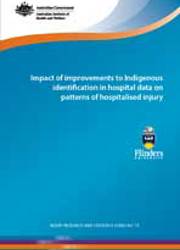Summary
This report examines the effects of improvements in Indigenous identification in hospitals data on patterns of hospitalised injury among Aboriginal and Torres Strait Islander people. These improvements have resulted in the inclusion of hospital separation data from New South Wales and Victoria in addition to data from the Northern Territory, Western Australia, South Australia and Queensland in analyses of hospitalised injury.
Key findings
The primary difference between the demographic profiles of Aboriginal and Torres Strait Islander people from New South Wales and Victoria (referred in this report as the 'two state group') compared with those from the Northern Territory, Western Australia, South Australia and Queensland (referred as the 'four state group') is the distribution by remoteness. Aboriginal and Torres Strait Islander people from Northern Territory, Western Australia, South Australia and Queensland live predominantly in more regional and remote locations compared with those from New South Wales and Victoria.
The inclusion of hospitalisation data from New South Wales and Victoria has led to a change in the injury profile of Aboriginal and Torres Strait Islander people. Much of the change appears to be driven by the differences in the proportion of Aboriginal and Torres Strait Islander people by remoteness between the two groupings.
Overall, age-standardised rates of injury were lower in the two state group (2,528 per 100,000 population) compared with the four state group (4,120). Hence, the effect of combining the two groups generally was a lowering of hospitalised injury rates (six state group: 3,523 per 100,000) compared with rates for the four state group for all but a small number of age ranges, for males, females and all persons.
An analysis of four of the priority Aboriginal and Torres Strait Islander injury issues identified within The National Aboriginal and Torres Strait Islander Safety Promotion Strategy-social and emotional wellbeing, child and young people's safety, violence affecting families and individuals, and land transport-revealed the extent of the impact of the inclusion of cases from New South Wales and Victoria on the pattern of injury.
Rates of injury for assault and transport in Aboriginal and Torres Strait Islander people decreased with the inclusion of cases from New South Wales and Victoria. In contrast, the rate of hospitalised self-harm increased (four state group: 233 cases per 100,000 population; six state group: 248 per 100,000). For Aboriginal and Torres Strait Islander children rates of hospitalised injury decreased with the inclusion of cases from New South Wales and Victoria; 2,053 cases per 100,000 population compared with 1,826 respectively.
The message
Patterns of hospitalised injury for Aboriginal and Torres Strait Islanders based on analyses of the data for the six states were different from patterns based on analyses based on data for the four state group. Users of the data will need to exercise caution in comparing changes over time if the number of states used in data analysis has changed.



